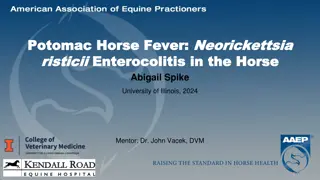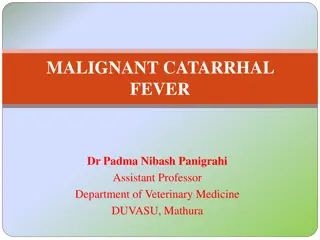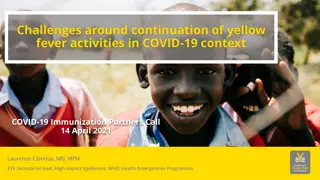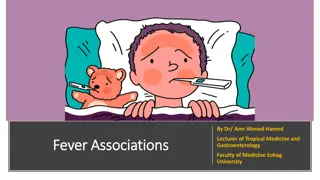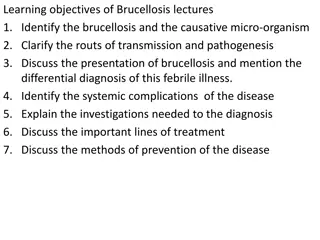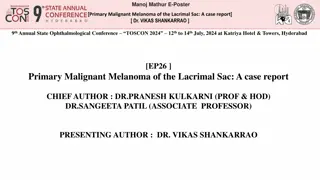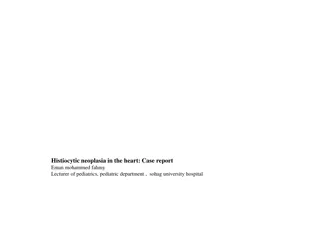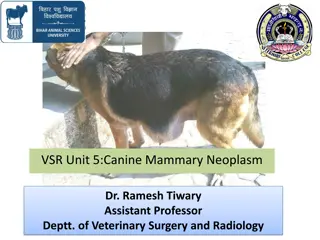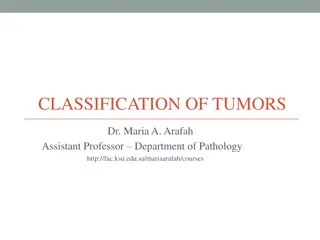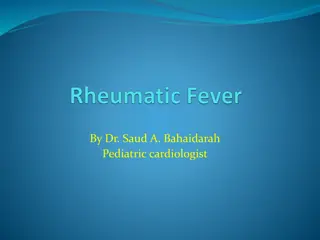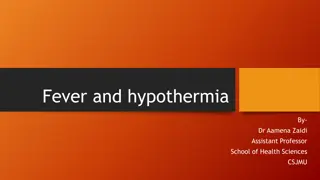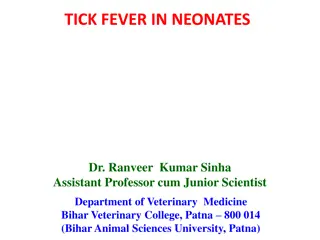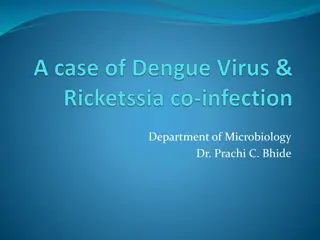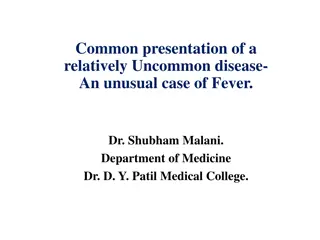Understanding Tumor Classification and Nomenclature in Pathology
This slideshow provides an overview of tumor classification, nomenclature, and key concepts in pathology. It covers the definitions of neoplasm, tumor, and oncology, the classification of tumors into benign and malignant categories, as well as the importance of stroma in tumor behavior. It also expl
2 views • 61 slides
Understanding Acute Rheumatic Fever: Causes, Symptoms, and Impact
Acute Rheumatic Fever (ARF) is a multisystem disease resulting from an autoimmune response to a sore throat caused by Group A beta-hemolytic Streptococci. It primarily affects children aged 5-14 years and can lead to rheumatic heart disease (RHD), which is the most common cause of heart disease in c
2 views • 48 slides
Understanding Malignant Melanoma: Types, Signs, and Prognosis
Malignant melanoma is a serious skin cancer with various types, including superficial spreading, nodular, acral lentiginous, lentigo maligna, and amelanotic. Recognizing early signs such as ABCDEF (Asymmetry, Borders, Colour, Diameter, Evolving, Funny-looking) is crucial for prompt diagnosis. Macros
2 views • 25 slides
Potomac Horse Fever: Clinical Presentation and Diagnostic Plan
A 5-year-old Quarter Horse gelding presents with symptoms of colic and possible Potomac Horse Fever. Initial physical examination reveals sweating, tachycardia, and abnormal bowel sounds. The differential diagnoses include gastrointestinal infections, viral and bacterial causes. The diagnostic plan
1 views • 15 slides
Understanding Testicular Tumors: Types, Classification, and Clinical Findings
Testicular tumors are predominantly malignant, with germ cell tumors being the most common type. This article delves into the classification of testicular tumors, including primary and secondary, benign and malignant, germ cell, and non-germ cell tumors. Clinical findings such as painless enlargemen
3 views • 31 slides
Case Review: Diagnostic Dilemma in Urology - Management Approach for a Patient with Abdominal Pain and Fever
A 58-year-old man with a history of diabetes and hypertension presents with fever and abdominal pain, raising multiple differential diagnoses including symptomatic AAA, pyelonephritis, acute appendicitis, complicated urolithiasis, or diabetic ketoacidosis. The case explores clinical manifestations,
1 views • 35 slides
Mystery Case Study: 75-Year-Old Male with Fever and Altered Mental Status
A 75-year-old male with a history of multiple animal exposures presented with fever, altered mental status, headache, and diarrhea. Physical exam revealed vital signs within normal limits, and labs showed various results including negative infectious disease workup but pending further tests. Imaging
0 views • 11 slides
Understanding Enteric Fever (Typhoid Fever): Causes, Contagiousness, and Prognosis
Enteric fever, commonly known as typhoid fever, is an acute illness caused by Salmonella typhi bacteria transmitted through contaminated food or water. This fever is highly contagious, with individuals becoming carriers even after recovering. Close contact, contaminated water, and poor sanitation co
0 views • 18 slides
Understanding Grading and Staging of Malignant Tumors in Cancer Patients
Grading and staging are crucial in determining the aggressiveness and extent of malignant tumors. Grading involves assessing the level of malignancy based on cell differentiation and mitotic activity, while staging considers the size of the tumor, lymph node involvement, and presence of metastases.
7 views • 31 slides
Understanding Ephemeral Fever/Three-Day Sickness in Cattle and Water Buffalo
Ephemeral fever (Three-Day Sickness) is an acute arthropod-borne viral disease affecting cattle and water buffalo. It is caused by the Bovine Ephemeral Fever Virus and manifests with biphasic fever, decreased milk yield, and other clinical signs. The disease has varying prevalence and can lead to hi
0 views • 7 slides
Foot and Mouth Disease: Overview, Symptoms, and Sequelae
Foot and Mouth Disease, also known as Aphthous fever, is a highly contagious viral infection affecting cloven-hoofed animals. It is characterized by the formation of vesicles and erosions in the mouth, nose, teats, and feet. The disease can cause a fall in milk yield, high fever, loss of appetite, a
1 views • 8 slides
Understanding Bluetongue Disease in Sheep, Cattle, and Goats: Causes, Symptoms, and Diagnosis
Bluetongue disease is a viral illness predominantly affecting sheep, with occasional cases in cattle and goats. Transmitted by insect vectors, it can lead to various symptoms such as catarrhal stomatitis, lameness, and reproductive issues. The disease's impact, transmission methods, clinical signs,
0 views • 8 slides
Pediatric Case Presentation: Fever and Rash in a 3-Year-Old Patient
A 3-year-old female presented with fever, rash, cough, vomiting, diarrhea, and dyspnea. History revealed incomplete immunization and household fever cases. Physical exam showed tachycardia, respiratory distress, rash, and other symptoms. Past medical history indicated normal development and perinata
0 views • 26 slides
Neuroleptic Malignant Syndrome and Serotonin Syndrome Overview
This educational material provides an in-depth understanding of Neuroleptic Malignant Syndrome (NMS) and Serotonin Syndrome (SS) including their background, pathophysiology, clinical characteristics, differential diagnosis, risk factors, and treatment approaches. It also explores the historical back
3 views • 53 slides
Overview of Malignant Catarrhal Fever in Cattle and Other Species
Malignant catarrhal fever (MCF) is a fatal disease affecting various species, caused by two different viruses transmitted from wild animals. It is characterized by low morbidity but high mortality rates, with distinct clinical signs such as sudden death, head and eye manifestations, and intestinal i
0 views • 24 slides
Understanding Bovine Ephemeral Fever: Key Information and Insights
Bovine Ephemeral Fever, also known as Three-Day Sickness or Three-Day Fever, is an economically important arboviral disease affecting cattle and water buffalo in tropical and semitropical regions. It is caused by an arthropod-borne rhabdovirus and primarily transmitted by mosquitoes and biting midge
0 views • 19 slides
Comprehensive Overview of Parotid Tumor Diagnosis and Management
This comprehensive guide covers the diagnosis and management of parotid tumors, including anatomy, differential diagnosis, and management strategies. It discusses the approach to evaluating patients with neck lumps, differential diagnoses to consider, and the management techniques for both benign an
0 views • 20 slides
Ignaz Semmelweis and the Fight Against Puerperal Fever
Ignaz Semmelweis, a pioneer in antiseptic procedures, determined the cause of puerperal fever in the 19th century. His work led to a significant reduction in maternal mortality by identifying the importance of handwashing in healthcare settings. Puerperal fever, a common cause of death in women afte
0 views • 29 slides
Understanding Sore Throats and Rheumatic Fever
Learn about the impact of sore throats and rheumatic fever, particularly on Maori and Pacific families. Discover how rheumatic fever affects the body and ways to protect your whanau. Find information on treating strep throat and getting help from health workers or the Healthline. Acknowledgements to
0 views • 12 slides
Yellow Fever: Adverse Reactions and Risks
Yellow fever vaccination can lead to severe adverse reactions like anaphylaxis, neurotropic disease, and viscerotropic disease. These reactions can range from immediate hypersensitivity to rare but serious outcomes such as meningitis and multiple system organ failure. The mortality rate associated w
0 views • 11 slides
Challenges in Continuing Yellow Fever Activities Amid COVID-19
Challenges persist in sustaining yellow fever activities during the COVID-19 pandemic, with decreased surveillance, delayed outbreak responses, and logistical disruptions impacting efforts to eliminate yellow fever epidemics. The EYE partnership focuses on protecting at-risk populations, preventing
0 views • 9 slides
Summer Sufferings: Treatment Options for Hay Fever and Related Conditions
Dr. Craig Masson, a GP in Clarkston, East Renfrewshire, discusses prescribing and non-prescribing options for hay fever, sinusitis, prickly heat, urticaria, and Lyme disease. The content covers the challenges of managing hay fever symptoms including grass and pollen allergies, and suggests non-pharm
0 views • 24 slides
Fever Associations and Clinical Presentations in Tropical Medicine and Gastroenterology
This presentation by Dr. Amr Ahmed Hamed, a lecturer at Sohag University, explores various fever associations and clinical presentations related to tropical medicine and gastroenterology. Topics covered include fever with jaundice, sweating, rigors, hepatomegaly, splenomegaly, rash, lymphadenopathy,
0 views • 25 slides
Comprehensive Overview of Brucellosis: Causes, Transmission, Diagnosis, and Treatment
Brucellosis, also known as Malta fever or Mediterranean fever, is a systemic bacterial infection caused by Brucella species. This overview covers the identification of the disease, its transmission methods, clinical presentation, complications, diagnostic investigations, treatment options, and preve
0 views • 12 slides
Management of Malignant Ascites in Advanced Cancer: ESDO Learning
Malignant ascites is a challenging complication of advanced cancer, impacting patient quality of life and survival. Diagnosis involves imaging and cytology, with poor prognostic indicators. Management includes symptom relief with diuretics, paracentesis, and catheter options. Refractory cases presen
0 views • 7 slides
Understanding Malignant Hyperthermia: Causes, Management, and Epidemiology
Malignant Hyperthermia (MH) is a genetic disorder of skeletal muscle triggered by certain anesthetics, leading to a hyper-metabolic state. The uncontrolled release of calcium results in muscle rigidity, metabolic acidosis, hyperthermia, and other serious complications. MH was first described in the
0 views • 24 slides
Primary Malignant Melanoma of the Lacrimal Sac: A Rare Case Report
Malignant melanoma of the lacrimal sac is a rare condition that poses challenges in early diagnosis due to its insidious onset. This case study discusses the presentation, diagnosis, and treatment of a 78-year-old woman with a palpable mass in the lacrimal sac, highlighting the importance of early i
0 views • 6 slides
Histiocytic Neoplasia in the Heart: A Rare Case Report
A 3-year-old girl presented with persistent fever, leading to the discovery of a cardiac mass diagnosed as histiocytic neoplasia through imaging and biopsy. Primary cardiac tumors are rare in children, with benign tumors being more common. Histiocytic sarcomas are malignant neoplasms with characteri
0 views • 10 slides
Canine Mammary Neoplasms: Overview and Management by Dr. Ramesh Tiwary
Canine mammary neoplasms, including benign adenomas and malignant carcinomas, are common in intact female dogs. This article discusses the clinical signs, diagnosis methods like FNAC and biopsy, WHO clinical staging system, and the importance of palpating regional lymph nodes for prognosis assessmen
0 views • 15 slides
Classification of Tumors: A Comprehensive Overview
Understanding the classification of tumors is crucial in the field of pathology. This detailed overview covers the definitions of neoplasia and tumors, the differentiation between benign and malignant tumors, nomenclature, and characteristics of various tumor types. It discusses the behaviors of ben
1 views • 34 slides
Rheumatic Fever: A Comprehensive Overview of Epidemiology, Pathogenesis, and Clinical Features
Rheumatic fever is a delayed autoimmune reaction to group A, B-hemolytic streptococcal pharyngitis in genetically susceptible individuals. This condition involves the heart, joints, brain, skin, and serous surfaces. The incidence varies between developing and developed countries, with environmental
0 views • 31 slides
Understanding Fever and Hypothermia: Body Temperature Regulation
Body temperature is the balance between heat production and heat loss, crucial for maintaining health. Fever and hypothermia are conditions where body temperature is elevated or decreased respectively. Factors like age, exercise, hormonal levels, stress, and environment can affect body temperature.
0 views • 10 slides
Malignant Melanoma of Left Eye Lower Lid - Case Presentation
A rare case of malignant melanoma affecting the lower lid of a 50-year-old female is discussed in this e-poster. The lesion, with characteristic pigmentation and irregular borders, was successfully diagnosed through incision biopsy and histopathological examination. The patient underwent wide excisi
0 views • 6 slides
Understanding Tick Fever in Neonates: Symptoms, Diagnosis, Treatment, and Prevention
Tick fever in neonates is a febrile disease transmitted by tick bites, with symptoms including fever, loss of appetite, depression, weakness, red urine, anemia, and jaundice. The disease can be diagnosed through clinical symptoms, tick presence, and blood smear examination. Treatment involves medica
0 views • 9 slides
Case Study: 55-Year-Old Male Patient with Fever, Breathlessness, and LRTI
A 55-year-old male presented with fever, breathlessness, and a history of Dengue fever. Further investigations revealed Diabetes Mellitus and LRTI with AKI. Treatment included antibiotics and supportive care.
0 views • 16 slides
Overview of Renal Tumors: Benign and Malignant Forms
Explore the spectrum of renal tumors, from benign papillary adenomas and oncocytomas to malignant renal cell carcinomas like clear cell carcinoma. Images and descriptions showcase the gross pathology and histopathology of these tumors. Learn about the features and prognosis of different renal tumor
0 views • 31 slides
Non-Malignant Haematology Clinical Trials at Hammersmith Hospital: Latest Research Updates
Explore the latest updates from the Non-Malignant Haematology Clinical Trials Unit at Hammersmith Hospital, including studies on Red Cell Disorders and the REDRESS trial for severe sickle cell disease. Learn about ongoing trials, inclusion criteria, and contact information for participation.
0 views • 11 slides
Overview of Rift Valley Fever: Symptoms in Animals and Humans
Rift Valley Fever (RVF) is an acute viral hemorrhagic fever primarily affecting domesticated animals and humans. The disease is caused by the RVF virus transmitted through mosquito bites or contact with infected animal tissues. In animals, clinical signs vary with high mortality rates in young lambs
0 views • 10 slides
Unusual Case Presentation of Fever in a Young Adult Male
A 24-year-old male student presented with a one-month history of moderate to high-grade fever. This unusual case of a prolonged fever warrants thorough investigation to identify the underlying cause.
1 views • 20 slides
Understanding Leukaemia: Causes, Symptoms, and Management
Leukaemia is a malignant disorder of the blood-forming organs characterized by an abnormal increase in white blood cells. Its causes include genetic, environmental, and medical factors. Symptoms may include anaemia, fever, fatigue, and more. Diagnosis involves history collection, physical examinatio
0 views • 10 slides



